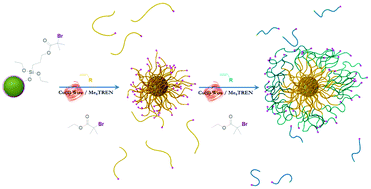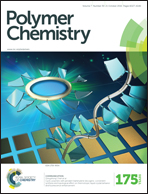Surface-initiated SET living radical polymerisation for the synthesis of silica–polymer core–shell nanoparticles†
Abstract
We report the use of surface-initiated single-electron transfer living radical polymerisation (SI SET-LRP) to prepare inorganic–organic core–shell nanoparticles with functional grafted chains of high molecular weight. The potential of SI SET-LRP is demonstrated by the preparation of a series of silica–polymer core–shell materials from a silica nanoparticle template bearing a bromo ester initiating group in the presence of a free initiator, with detailed kinetic investigations using methyl acrylate and tert-butyl acrylate. Under optimised polymerisation conditions, concentrated polymer brushes with grafting densities as high as 0.8 chains per nm2 and relatively high molecular weight polymer grafts (degree of polymerisation, DPn, up to 1000) were achieved whilst employing a heterogeneous copper(0) wire catalyst at low polymerisation temperatures. Under optimal conditions, the polymer shell grows similarly to the free polymer with increasing monomer conversion to produce well-defined monodisperse particles with a narrow size distribution. The particle uniformity results in the formation of particle assemblies that display long-range 2D and 3D order, as characterised by electron microscopy.



 Please wait while we load your content...
Please wait while we load your content...